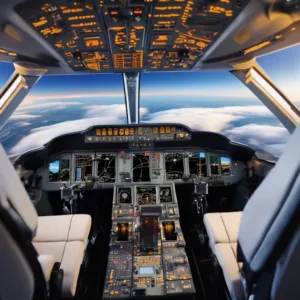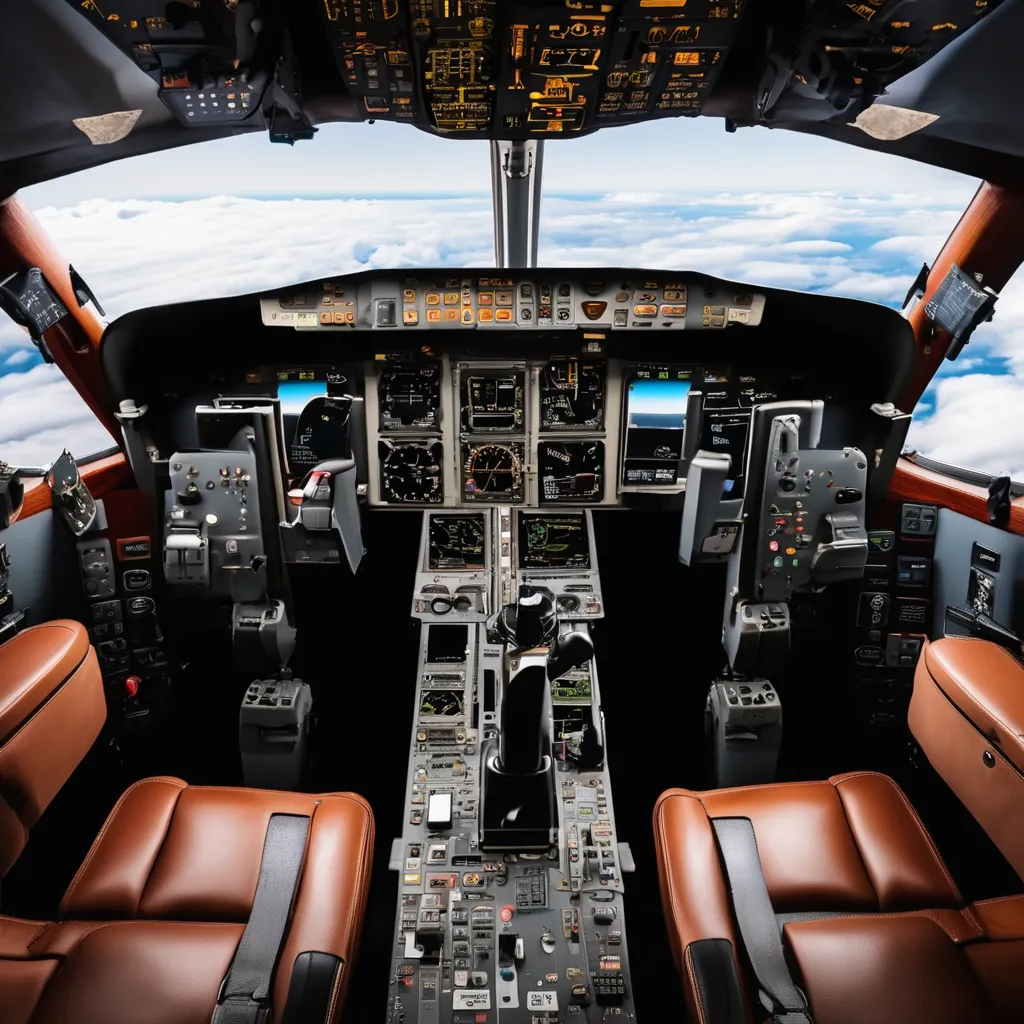Understanding the Autopilot System in Modern Aviation
In the realm of modern aviation, the autopilot system stands as a pivotal technological advancement that has revolutionized the way aircraft are operated. Autopilot systems are designed to perform a wide range of tasks that assist pilots in controlling the aircraft, thereby enhancing flight safety, efficiency, and reliability. This article delves into the intricate workings of autopilot systems, tracing their evolution, and exploring their various functionalities and impacts on aviation.
The History and Evolution of Autopilot Technology
The concept of autopilot technology can be traced back to the early 20th century. The first autopilot system, developed by Sperry Corporation in 1912, was a simple mechanism that could maintain an aircraft’s heading and altitude. Over the decades, significant advancements have been made, incorporating more sophisticated electronics and computer systems. The transition from mechanical to digital autopilots marked a significant leap, enabling more precise control and integration with other aircraft systems.
Modern autopilot systems are highly advanced, utilizing complex algorithms and sensors to perform a multitude of tasks. The evolution of autopilot technology has been driven by the need for enhanced safety, efficiency, and the ability to handle more complex flight operations. Today’s autopilots can manage entire flight phases, from takeoff to landing, with minimal pilot intervention.
Key Components of an Aircraft’s Autopilot System
An aircraft’s autopilot system comprises several key components that work in unison to control the aircraft. These include the flight control computer, sensors, actuators, and control panels. The flight control computer is the brain of the autopilot system, processing inputs from various sensors and executing control commands.
Sensors play a crucial role in providing real-time data on the aircraft’s attitude, altitude, speed, and position. These include gyroscopes, accelerometers, and GPS receivers. Actuators are responsible for moving the aircraft’s control surfaces, such as the ailerons, elevators, and rudder, based on commands from the flight control computer. Control panels allow pilots to input desired flight parameters and monitor the system’s performance.
How Autopilot Enhances Flight Safety
Autopilot systems significantly enhance flight safety by reducing pilot workload and minimizing human error. By automating routine tasks, pilots can focus on monitoring the flight and handling unexpected situations. Autopilots are designed to operate within strict safety parameters, ensuring that the aircraft remains within safe operational limits.
Moreover, autopilot systems are equipped with multiple redundancies and fail-safes to prevent malfunctions. They continuously monitor the aircraft’s performance and can alert pilots to any anomalies. In critical situations, autopilots can take corrective actions faster than a human pilot, thereby averting potential accidents.

The Role of Autopilot During Takeoff and Landing
While autopilot systems are highly effective during cruise flight, their role during takeoff and landing is more limited. Takeoff is a complex phase that requires precise control and situational awareness, typically managed by the pilot. However, modern autopilot systems can assist during this phase by maintaining the aircraft’s heading and initial climb rate.
During landing, autopilot systems can perform automated landings under certain conditions, known as autoland. This capability is particularly useful in poor visibility conditions, such as fog or heavy rain. Autoland systems use advanced sensors and navigation aids to guide the aircraft to a safe touchdown, ensuring a smooth and precise landing.
Autopilot Functions in Cruise Flight
The cruise phase of flight is where autopilot systems truly shine. During this phase, autopilots maintain the aircraft’s altitude, speed, and heading, allowing pilots to focus on monitoring systems and planning for the descent and landing. Autopilots can also perform more complex maneuvers, such as altitude changes and course adjustments, based on inputs from the flight management system.
Autopilot systems are equipped with advanced algorithms that optimize the aircraft’s performance, ensuring efficient fuel consumption and adherence to the flight plan. They can also manage the aircraft’s response to turbulence, providing a smoother ride for passengers and reducing pilot workload.
Navigational Capabilities of Modern Autopilot Systems
Modern autopilot systems are integrated with sophisticated navigation systems, enabling precise and reliable navigation. These systems use a combination of GPS, inertial navigation systems (INS), and radio navigation aids to determine the aircraft’s position and guide it along the planned route.
Autopilots can perform complex navigational tasks, such as following predefined waypoints, executing holding patterns, and conducting instrument approaches. They can also interface with air traffic control (ATC) systems, allowing for seamless coordination and compliance with ATC instructions. This integration enhances situational awareness and ensures safe and efficient flight operations.
Automatic Altitude and Speed Control in Aircraft
One of the primary functions of autopilot systems is to maintain the aircraft’s altitude and speed. This is achieved through the use of altitude and speed hold modes, which automatically adjust the aircraft’s control surfaces and engine thrust to maintain the desired parameters.
Altitude control is achieved by adjusting the pitch of the aircraft, while speed control is managed by varying the engine power. Autopilot systems continuously monitor the aircraft’s altitude and speed, making fine adjustments to ensure precise control. This capability is particularly useful in maintaining optimal flight profiles and complying with ATC altitude and speed restrictions.
The Integration of Autopilot with Flight Management Systems
Autopilot systems are closely integrated with flight management systems (FMS), which are responsible for managing the overall flight plan. The FMS provides the autopilot with critical information, such as the planned route, waypoints, and performance data. This integration allows the autopilot to execute the flight plan with high precision and efficiency.
The FMS also provides real-time updates on the aircraft’s position, fuel status, and estimated arrival times. This information is used by the autopilot to optimize the flight path and manage fuel consumption. The seamless integration of autopilot and FMS enhances situational awareness and ensures that the aircraft adheres to the planned route and performance parameters.
Human Factors: Pilot Interaction with Autopilot
While autopilot systems offer significant benefits, the interaction between pilots and autopilot systems is a critical factor in ensuring safe and effective flight operations. Pilots must be thoroughly trained to understand the capabilities and limitations of the autopilot system, as well as how to manage any malfunctions or anomalies.
Effective pilot-autopilot interaction requires a high level of situational awareness and the ability to make informed decisions. Pilots must continuously monitor the autopilot’s performance and be prepared to take manual control if necessary. Clear communication and coordination between the pilot and autopilot are essential to ensure safe and efficient flight operations.
Autopilot in Adverse Weather Conditions
Adverse weather conditions pose significant challenges to flight operations, and autopilot systems play a crucial role in managing these challenges. Modern autopilot systems are equipped with advanced sensors and algorithms that enable them to handle turbulence, wind shear, and other weather-related phenomena.
In turbulent conditions, autopilot systems can make rapid adjustments to the aircraft’s control surfaces to maintain stability and provide a smoother ride for passengers. In the event of severe weather, such as thunderstorms or heavy rain, autopilots can assist in navigating around the weather and ensuring a safe flight path.
The Impact of Autopilot on Fuel Efficiency
Fuel efficiency is a critical factor in modern aviation, and autopilot systems contribute significantly to optimizing fuel consumption. By maintaining precise control of the aircraft’s altitude, speed, and flight path, autopilots ensure that the aircraft operates within the most efficient parameters.
Autopilot systems can also execute fuel-saving maneuvers, such as step climbs and descents, which optimize the aircraft’s performance based on changing atmospheric conditions. The integration of autopilot with FMS allows for continuous monitoring and adjustment of the flight plan to maximize fuel efficiency and reduce operational costs.

Autopilot System Redundancies and Fail-safes
Safety is paramount in aviation, and autopilot systems are designed with multiple redundancies and fail-safes to ensure reliable operation. These redundancies include backup sensors, actuators, and flight control computers that can take over in the event of a primary system failure.
Fail-safes are built into the autopilot system to detect and respond to malfunctions. If an anomaly is detected, the autopilot can alert the pilot and automatically disengage, allowing the pilot to take manual control. These redundancies and fail-safes are critical in maintaining the safety and reliability of autopilot systems.
Training Pilots to Use Autopilot Systems Effectively
Effective use of autopilot systems requires comprehensive training for pilots. Training programs must cover the technical aspects of the autopilot system, as well as practical scenarios that pilots may encounter during flight. This includes normal and abnormal operations, as well as emergency procedures.
Pilots must be proficient in operating the autopilot system, understanding its capabilities and limitations, and managing any malfunctions. Training should also emphasize the importance of situational awareness and effective communication between the pilot and autopilot. Regular training and proficiency checks are essential to ensure that pilots can use autopilot systems effectively and safely.
The Future of Autopilot: Advancements in Artificial Intelligence
The future of autopilot systems is being shaped by advancements in artificial intelligence (AI) and machine learning. These technologies have the potential to enhance the capabilities of autopilot systems, enabling them to perform more complex tasks and make more informed decisions.
AI-driven autopilot systems can analyze vast amounts of data in real-time, allowing for more precise control and optimization of flight operations. Machine learning algorithms can continuously improve the performance of autopilot systems by learning from past experiences and adapting to new situations. The integration of AI into autopilot systems holds the promise of further enhancing flight safety, efficiency, and reliability.
Legal and Regulatory Aspects of Autopilot Use in Aviation
The use of autopilot systems in aviation is subject to strict legal and regulatory requirements. These requirements are established by aviation authorities, such as the Federal Aviation Administration (FAA) and the European Union Aviation Safety Agency (EASA), to ensure the safety and reliability of autopilot systems.
Regulations cover various aspects of autopilot use, including design, certification, operation, and maintenance. Aircraft manufacturers must demonstrate that their autopilot systems meet stringent safety standards, and operators must ensure that pilots are adequately trained to use these systems. Compliance with legal and regulatory requirements is essential to ensure the safe and effective use of autopilot systems in aviation.
Comparing Autopilot Systems Across Different Aircraft Models
Autopilot systems vary across different aircraft models, with each system tailored to the specific requirements and capabilities of the aircraft. While the basic principles of autopilot operation remain the same, the complexity and functionality of autopilot systems can differ significantly.
For example, autopilot systems in commercial airliners are highly advanced, with capabilities to manage entire flight phases and integrate with sophisticated navigation and flight management systems. In contrast, autopilot systems in smaller general aviation aircraft may have more limited functionality, focusing on basic tasks such as maintaining altitude and heading. Understanding these differences is important for pilots and operators to ensure the effective use of autopilot systems.
The Role of Autopilot in Reducing Pilot Workload
One of the primary benefits of autopilot systems is their ability to reduce pilot workload. By automating routine tasks, autopilots allow pilots to focus on more critical aspects of flight operations, such as monitoring systems, communicating with ATC, and managing unexpected situations.
Reduced workload leads to lower levels of fatigue and stress, enhancing pilot performance and decision-making. Autopilot systems also enable more efficient crew resource management, allowing pilots to work together more effectively and ensuring that tasks are distributed appropriately. This reduction in workload is a key factor in enhancing flight safety and efficiency.
Autopilot System Maintenance and Reliability
The maintenance and reliability of autopilot systems are critical to ensuring their safe and effective operation. Regular maintenance is required to keep autopilot systems in optimal condition, including checks on sensors, actuators, and flight control computers. Maintenance procedures must be performed by qualified technicians following stringent guidelines and standards.
Reliability is ensured through rigorous testing and certification processes, as well as the inclusion of redundancies and fail-safes. Autopilot systems are designed to withstand a wide range of operational conditions and to continue functioning even in the event of component failures. Ensuring the maintenance and reliability of autopilot systems is essential to maintaining the safety and efficiency of modern aviation.

Case Studies: Autopilot System Performance in Real-world Scenarios
Real-world scenarios provide valuable insights into the performance of autopilot systems. Case studies of autopilot system performance in various situations, such as adverse weather, technical malfunctions, and emergency situations, highlight the strengths and limitations of these systems.
For example, autopilot systems have demonstrated their ability to perform automated landings in low-visibility conditions, ensuring safe and precise touchdowns. In other cases, autopilot systems have successfully managed in-flight emergencies, such as engine failures, by maintaining control and guiding the aircraft to a safe landing. These case studies underscore the critical role of autopilot systems in enhancing flight safety and reliability.
The autopilot system is a cornerstone of modern aviation, providing significant benefits in terms of safety, efficiency, and reliability. From its early beginnings to the advanced systems in use today, autopilot technology has continually evolved to meet the demands of increasingly complex flight operations. By automating routine tasks and integrating with sophisticated navigation and flight management systems, autopilot systems reduce pilot workload and enhance overall flight performance. As advancements in artificial intelligence and machine learning continue to shape the future of autopilot technology, the potential for further enhancements in flight safety and efficiency is immense. Ensuring the effective use and maintenance of these systems, along with adherence to legal and regulatory requirements, is essential to realizing the full benefits of autopilot technology in aviation.







